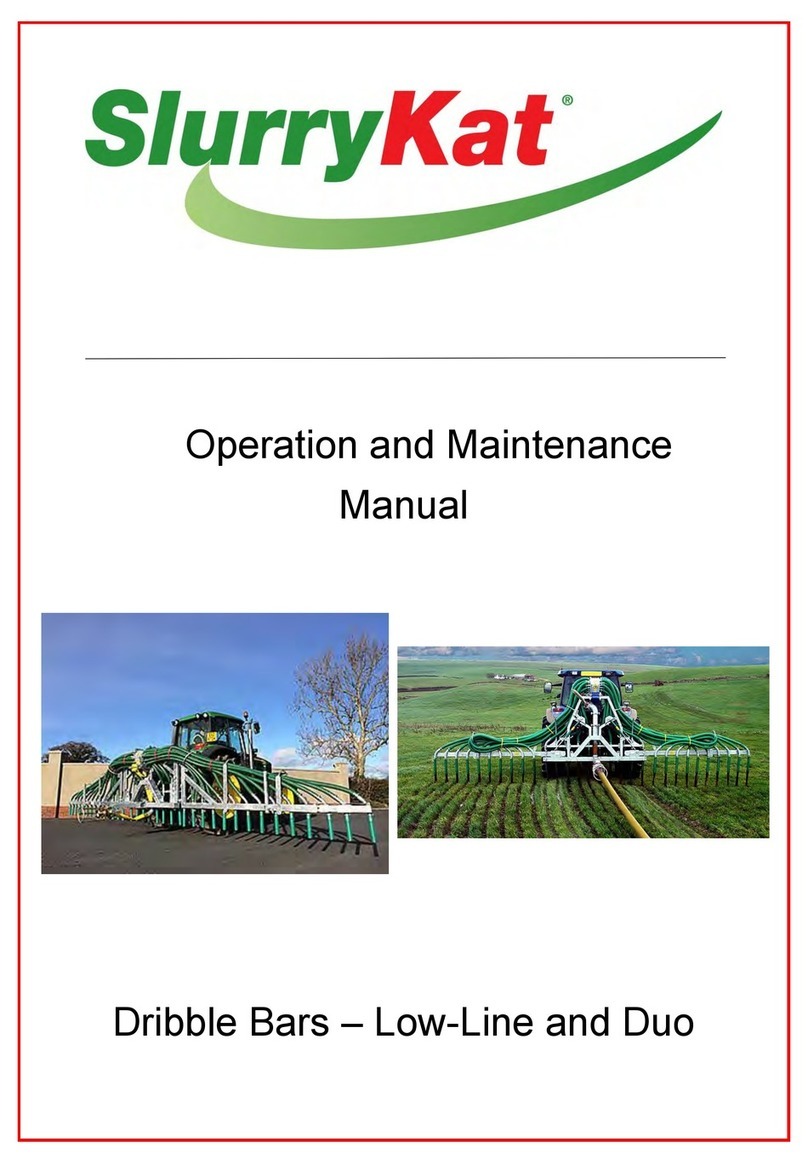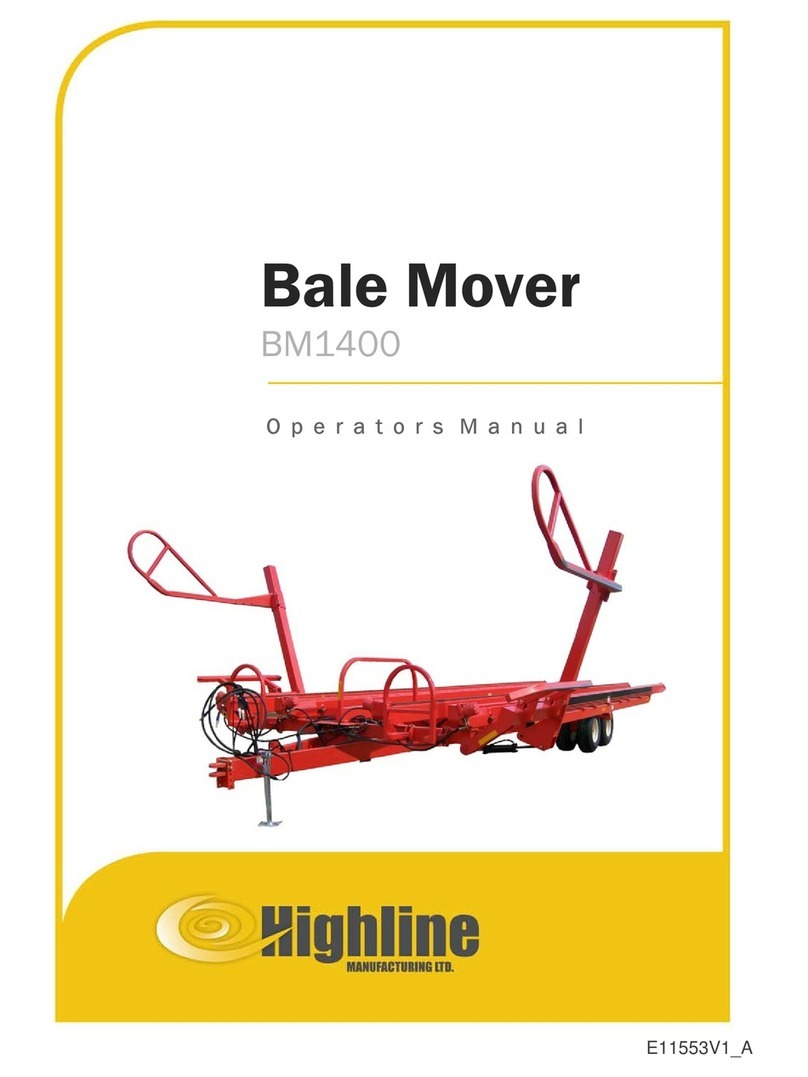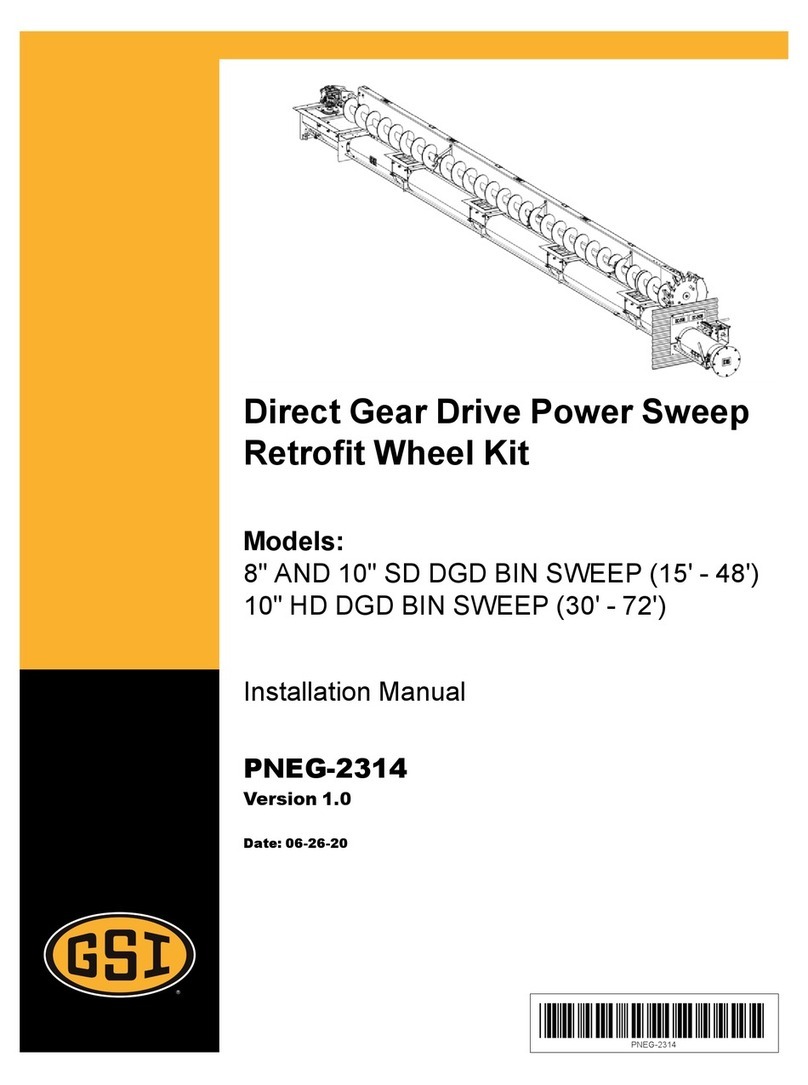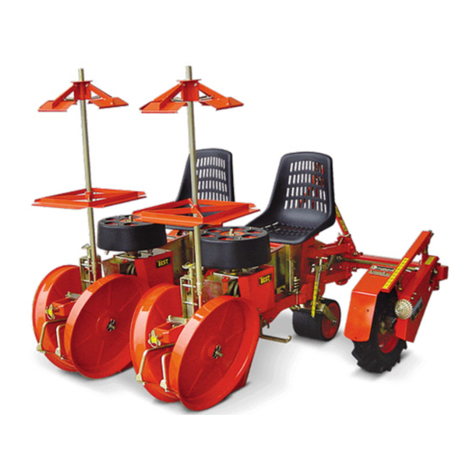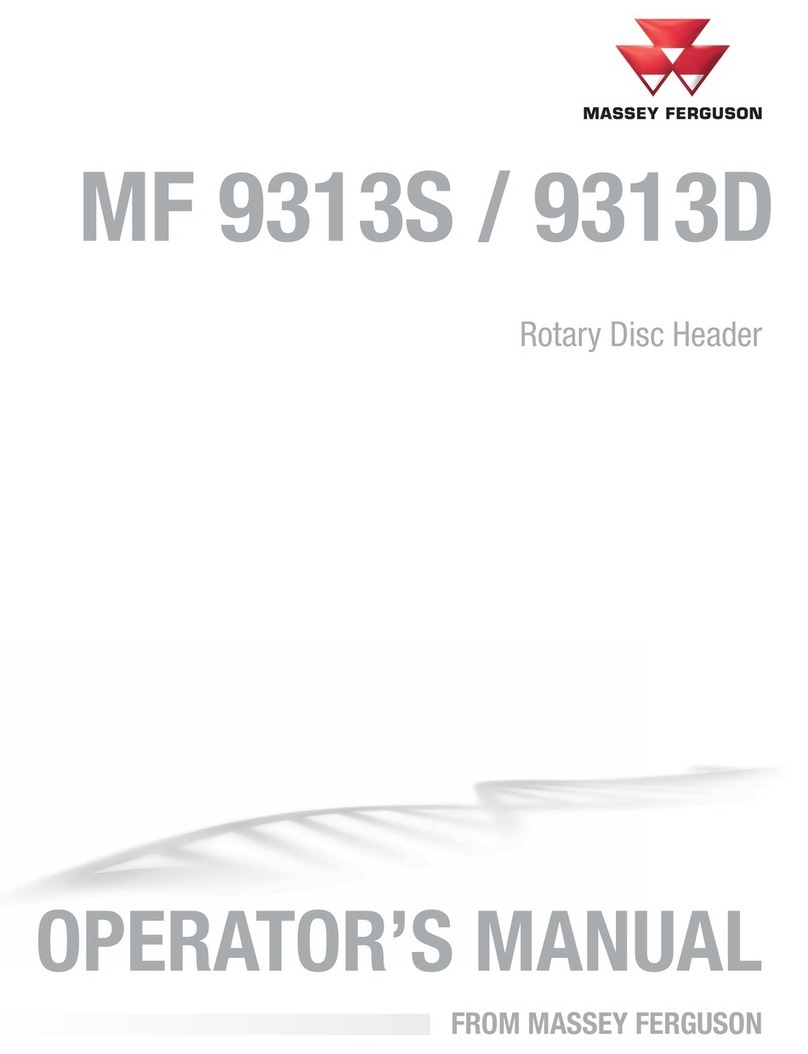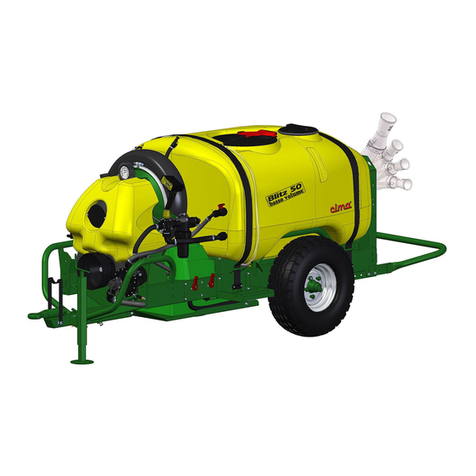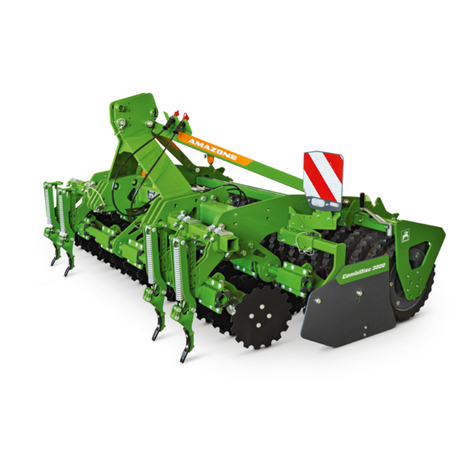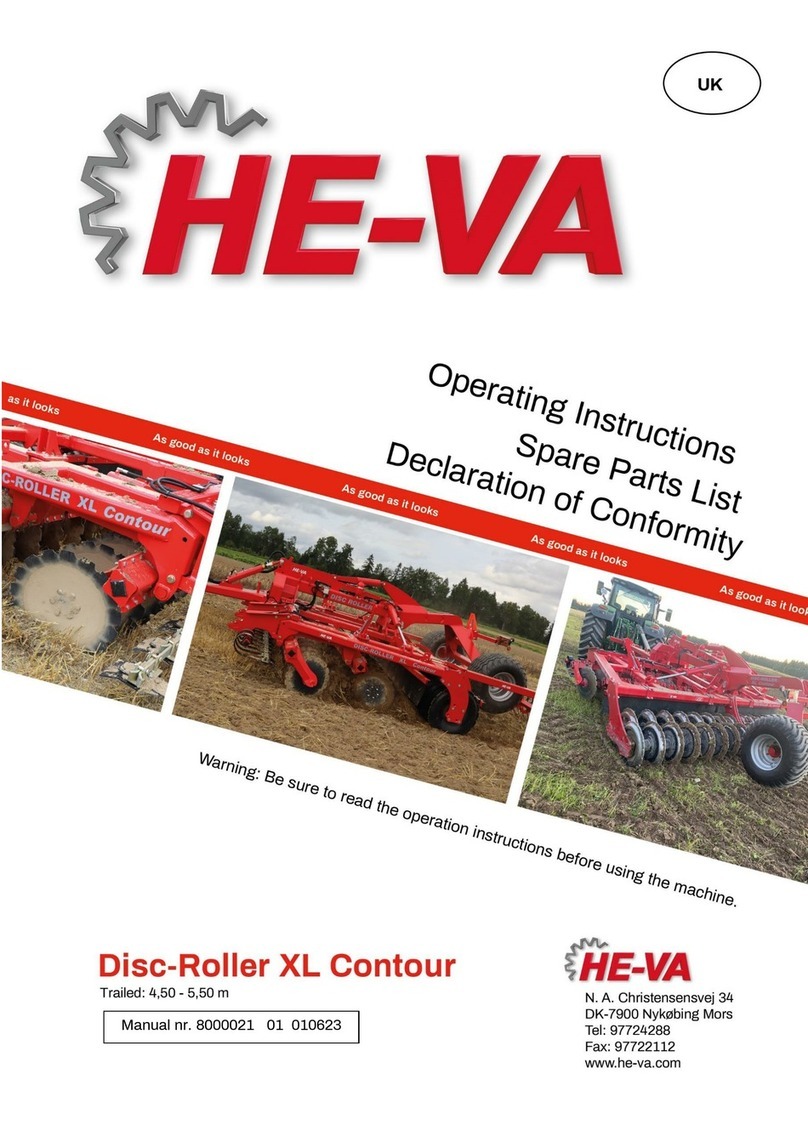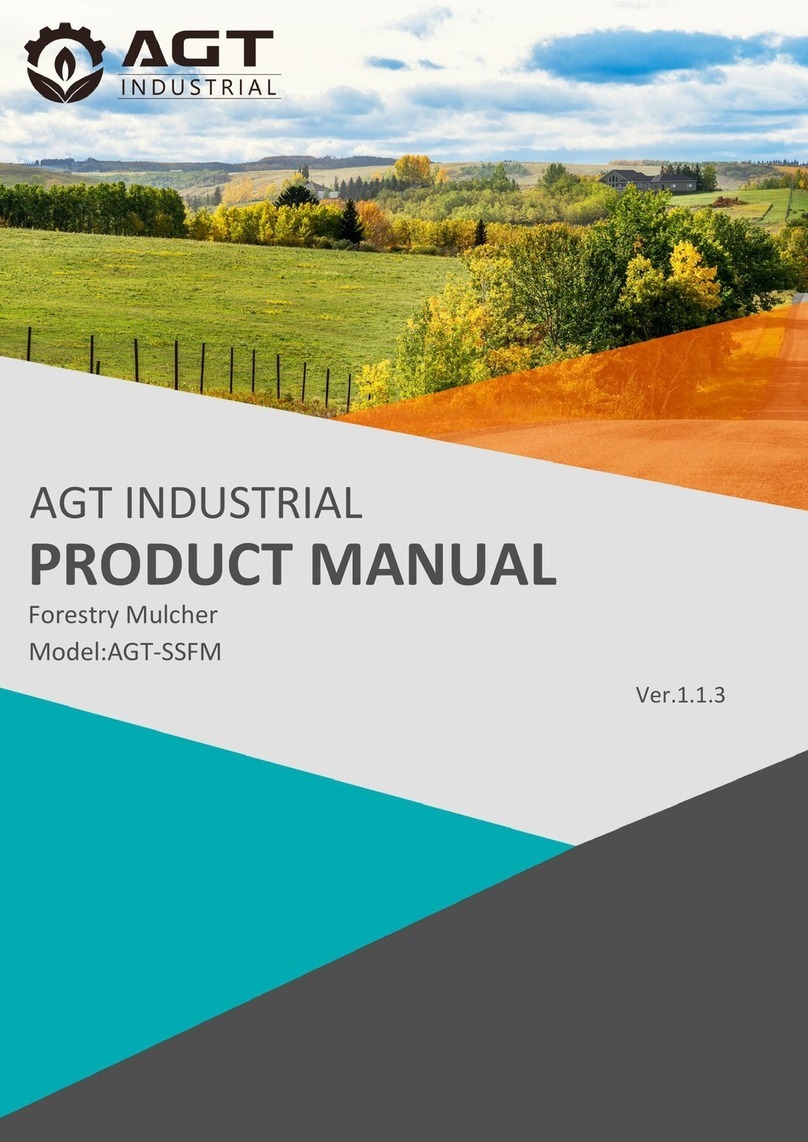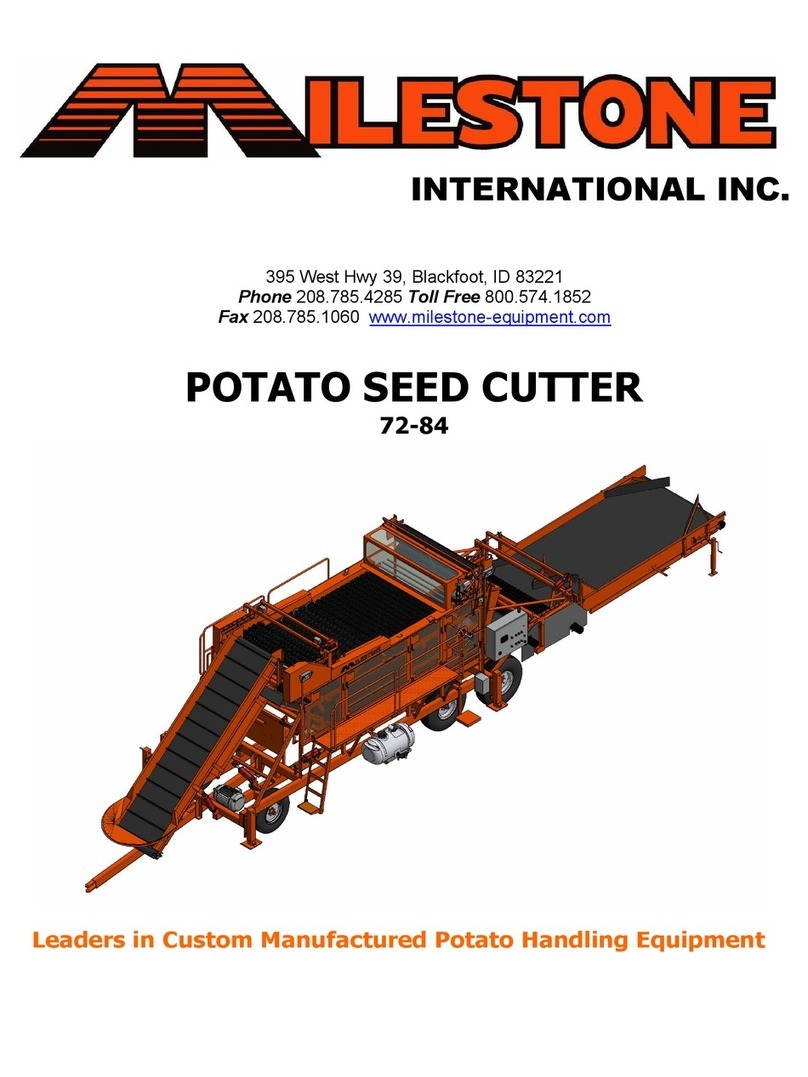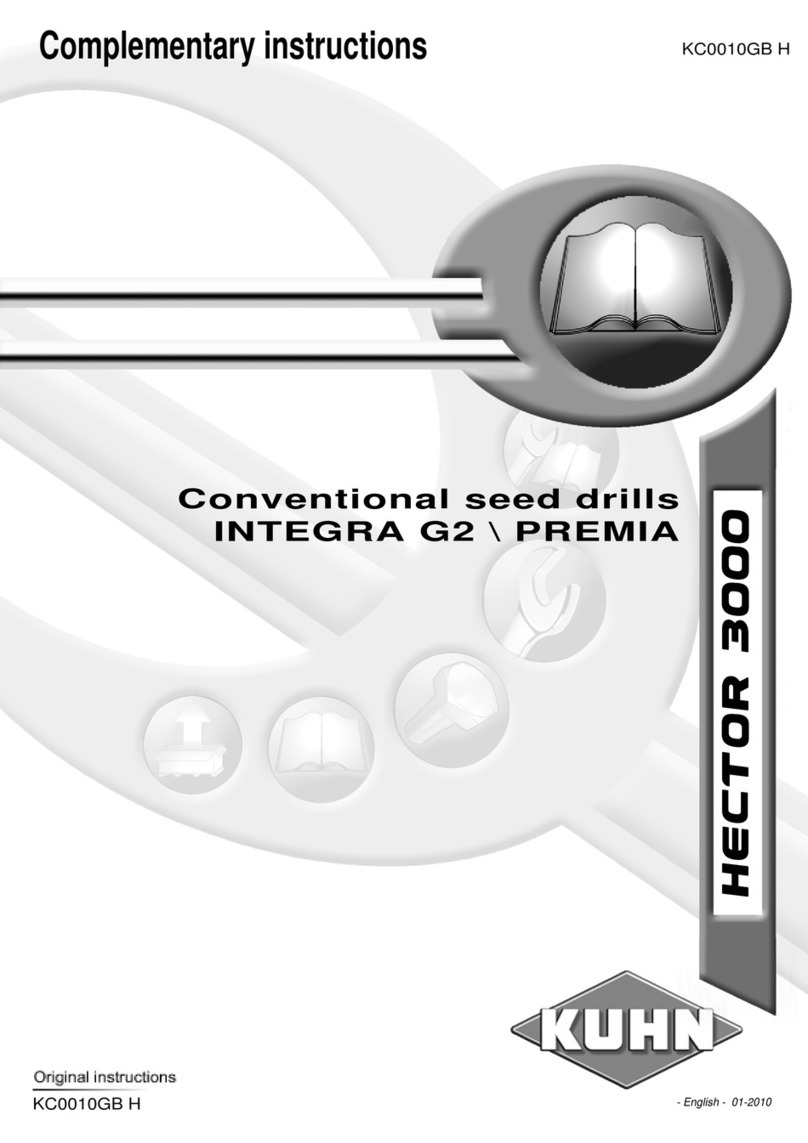SlurryKat BAK-PAK 600m User manual

Operation and Maintenance
Manual
BAK-PAK
Models 600m, 1000m and 1200m

Operation and Maintenance Manual –
BAK-PAK
2
Foreword
Dear user,
We would like to thank you for choosing SLURRYKAT equipment. This product
possesses a high level of technical reliability and will allow you to benefit from
SLURRYKAT’s vast experience in slurry spreading.
The aim of the manual is to help you use efficiently, correctly operate and service
your machine. Failure to do so could result in personal injury or equipment damage.
This manual and safety signs on your machine may be available in other languages,
(please arrange with managing director for order).
THIS MANUAL SHOULD BE CONSIDERED a permanent part of your machine and
should remain with the machine when you sell it.
Please contact your dealer should you have any questions about your SLURRYKAT
equipment.
Wishing you the best use of your SLURRYKAT equipment, we remain yours
faithfully,
G. Cairns
Managing Director

Operation and Maintenance Manual –
BAK-PAK
3
Contents
Foreword 2.
Contents 3.
General description 4.
Technical Specification 8.
Intended use 9.
General Safety Regulations 10.
Machine Markings 12.
Machine Marking Positions 13.
Instructions for use 14.
Pre use checks 14.
Attaching the BAK-PAK 15.
Reeling up hose 16.
Unreeling hose 18.
Detaching the BAK-PAK 19.
Cleaning 20.
Disposing of the machine 20.
Repairs 21.
Maintenance 22.
Grease points 23.
Replacing Drive Chain 24.
Hydraulic system 25.
Trouble Shooting 26.
Parts Diagrams 27.
Main assemblies 600m BAK-PAK 27.
Frame Components motor side 28.
Main assemblies 1000M BAK-PAK 29.
Frame components motor side ` 30.
Main assemblies 1200M BAK-PAK 31.
Frame components motor side 32.
Hydraulics Components 33.
Electric Schematics 34.
Drive Chain 35.
Terms of warranty 36.
Declaration of Conformity 38.

Operation and Maintenance Manual –
BAK-PAK
4
General Description
The Slurrykat BAK-PAK system offers a very compact system capable of reeling up
between 600m and 1200m of lay flat hose. The BAK-PAK is designed to be attached
using the quick release a-frame on the back of a dribble bar, single or double jet
spreader and 3-point linkage a-frame. This allows the BAK-PAK to be
attached/detached in a matter of second and the tractors hydraulic system provides
the power to operate the hydraulic motor.
The BAK-PAK combined with a front reeler provides an excellent package which
provides 800-2000m system that is very efficient. It comes standard with 360° swivel
to allow hose to untwist, greatly simplifying field operation.

Operation and Maintenance Manual –
BAK-PAK
5
600m BAK-PAK General Dimensions

Operation and Maintenance Manual –
BAK-PAK
6
1000m BAK-PAK General Dimensions

Operation and Maintenance Manual –
BAK-PAK
7
1200m BAK-PAK General Dimensions

Operation and Maintenance Manual –
BAK-PAK
8
Technical Specifications
BAK-PAK
Standard
• Available in 800m, 1000m, 1200m Capacities.
• Heavy duty A-Frame.
• Ergonomic design.
• Exceptionally strong but lightweight construction.
• Double rear hose rollers as standard.
• Can be used with any SlurryKat splash plate or dribble bar.
• 4-6 Split section reels. (Depending on model)
• High powered hydraulic motor. (c/w Pump Protection)
• Can be supplied with galvanised or paint finish.
Options
• 3-Point linkage with A-Frame
• Dual Motor (1000m)

Operation and Maintenance Manual –
BAK-PAK
9
Intended Use
THE BAK-PAK is designed SOLELY for use in customary agricultural applications
i.e ‘intended use’. If this machine is used in any other way, it is considered as
contrary to the intended use. Therefore, the manufacturer accepts no liability for
damage or injury resulting from this misuse, and these risks must be borne solely
with the user. Compliance and strict adherence to the conditions of operation,
service and repair as specified by the manufacturer also constitute essential
elements for the intended use.
Any person using this machine should read this manual carefully and strictly abide
by the legislation in terms of:
• Accident prevention
• Work safety
• Road safety
The user has to strictly respect all the warning signs affixed to the machine. Any
modifications done to the machine without prior written agreement of the
manufacturer, releases the manufacturer from responsibility for any damage which
might occur from this.

Operation and Maintenance Manual –
BAK-PAK
10
General Safety Regulations
Make sure all regulations concerning Work Safety and Highway Code are
respected, before you begin to use this equipment.
• Apart from the regulations specified in this manual, you should also abide by the
safety regulations and accident prevention legislations.
• Carefully read all instructions and safety messages in this manual and on your
machine.
• Abide by the Highway Code when on open roads. Use headlights, flashing warning
lights and turn signals day and night.
• Before using the machine the user should familiarise himself to the operating
systems of the machine and the respective functions.
• Do not wear any loose garments, which might get caught in the rotary parts of the
machine.
• Tie long hair behind you head and do not wear any neckties, scarves or necklaces
when operating machine or moving parts.
• The tractor should be fitted with a cabin or roll-over bar conforming to the
regulations in force.
• Before you start the machine, make sure that there is nothing in the immediate
vicinity and that the visibility is good. Keep all persons or animals out of the
machine’s danger zones.
• Carrying persons or animals on the machine during operating is strictly prohibited.
• When hitching or un-hitching the machine, make sure the feet are in the prescribed
position as indicated in the manual.
• Pay particular attention when hitching or un-hitching the machine from the tractor.
• Make sure that the tractor’s front axle ballast is sufficient before hitching the
machine to the tractor.
• Never exceed the maximum authorised axle load, from a technical and legal point
of view. Never exceed the total authorised laden weight during transport or when in
operation.
• Abide by the maximum authorised dimensions and loading gauge when driving on
public roads.
• Make sure that all guards and signalling systems are in good working order before
driving onto public roads.
• Keep all curtains, shields and remote control elements in place in such a way as to
avoid any accident or damage.
• Place the machine in transport position as indicated by the manufacturer before
driving onto open roads.
• Never leave the driving seat while the engine is running.

Operation and Maintenance Manual –
BAK-PAK
11
• Speed and driving behaviour should be adapted to suit the type of terrain. Avoid
sudden changes of direction. Do not exceed the recommended speed limit by the
manufacture of the machine.
• Always operate the machine at rated speed, provide sufficient weight to stabilize
the tractor when operating on hilly land or other adverse conditions.
• Pay particular attention in bends and avoid sudden moves by paying particular
attention to the length, height and weight of the machine attached.
• Before using the machine, make sure that all safety elements are in place and in
good working order. Replace missing or damaged safety signs.
• Before using the machine, check that all screws and bolts are well tightened.
Tighten is necessary.
• Do not stand in the immediate vicinity of the machine.
• Never lubricate service or adjust machine while moving, turn off engine, remove
key from ignition and wait for moving parts to have completely stopped.
•Do not stand between the tractor and the machine before putting on the hand brake.
• Before attempting any adjustments to the machine make sure it cannot be started
accidentally.
• Make sure the braking system is connected and working properly before moving
the machine.
• Do not support the machine on cinder blocks, hollow tiles or props that may
crumble under continuous load.
• Do not work under a machine that is supported solely by a jack; follow
recommended procedures in this manual.
• When implements or attachments are used with a machine, always follow safety
precautions listed in the operator’s manual.
Never Climb on Machine

Operation and Maintenance Manual –
BAK-PAK
12
Machine Markings
At several important places of this machine safety signs are affixed intended to
signify potential danger. The hazard is identified by a yellow warning sticker. Pictures
of the warning symbols you will expect to see are placed below with a brief
description.
These symbols are in place to minimise potential hazard
Danger! - Hazard points on this machine. Serious injury or death may
occur
Moving Parts - Keep clear of all moving parts. Risk of entanglement,
crushing or amputation
Pinch Point - Moving parts can cut or crush. Keep hands clear at all
times.
Grease - Grease should be applied every 10 hours, with 4-5 pumps
(and every 4-5 hours on PTO Shafts). This maintains machine for
optimum operating conditions
This symbol is in place to inform the user, to lubricate the chain
with chain oil every 20-25 hours

Operation and Maintenance Manual –
BAK-PAK
13

Operation and Maintenance Manual –
BAK-PAK
14
Instructions for Use
Storage Position - The BAK-PAK must be stored in the position shown in (Fig 1.1).
It should be set on a firm level surface
Checking the BAK-PAK before attaching and using-
1. Before using the BAK-PAK the user should check for any areas of wear
e.g. hydraulic components, bearings and pivot points etc.
2. The main body of the machine should also be checked to ensure there
are no cracks on welds, etc.
3. The attachment brackets have to be checked thoroughly to ensure they
are not damaged.
4. If there are any areas of wear or damage the machine must not be
used and be repaired immediately by a competent trained Engineer.
Fig 1.1 - BAK-PAK Storage Position

Operation and Maintenance Manual –
BAK-PAK
15
Attaching the BAK-PAK
1. Reverse the tractor up to the implement and stop at least 1m from it.
2. At this point turn off the tractor and engage the hand brake / park
brake, ensure the keys are removed.
3. If attaching the BAK-PAK with an A-Frame remove the two securing
pins (Fig 2.1).
4. Once removed the user may then proceed to back the tractor back in a
controlled and safe manor toward the BAK-PAK, ensuring to line the A-
Frame on the tractor with the A-Frame on the BAK-PAK.
5. Once lined up the user may then raise the A-Frame into position before
putting the securing pins back into their positions.
6. Connect the hydraulic hoses to the hydraulic supply of the tractor
ensuring the two hydraulic hoses are connected to the same double
acting cylinder service on the tractor.
7. The lighting socket should also be attached and lights should be
checked to ensure they are working.
8. When the BAK-PAK is mounted to the tractor ensure feet are clear and
not underneath it.
Always ensure that the machine is not left running or with the keys in it if the
user is not present in the driving seat to prevent incidents occurring.
Fig 2.1 - Location of Securing Pins on BAK-PAK
Fig 2.2 - Location of Securing Pins on A-Frame

Operation and Maintenance Manual –
BAK-PAK
16
Fig 3.1 - Direction of hose through guide rollers
Fig 3.2 - Location of hose end couplings
Start Up-
Before putting the machine to use, make sure the machine and all its components
are stable and brought to a standstill. Please make sure that you have followed all
the safety regulations as indicated in the first part of this manual.
Operating the BAK-PAK –
Reeling up of hose
1. Before starting ensure the tractor hand brake / park brake is on and the
engine is turned off. Then proceed to the back of the BAK-PAK.
2. Pull the hose through the two guide rollers as shown (Fig 3.1).
3. Place the hose end coupling into the reel (Fig 3.2).
4. Tractor hydraulic oil flow will need to be altered and usually reduced to slow
the reel down to a suitable speed which allows the hose to be reeled up in a
controlled manner. (Recommended operation speed is around 25-30 rpm.)
5. As the end of the hose approaches the reeler, the reel speed must be
reduced to 5rpm, to prevent the hose from jumping up over the top of the reel.
This will cause damage to the reel and tractor and may also result in personal
injury to the user.
6. Once reeling has been secure the coupling to the reel using a bungee cord or
a piece of rope, ensure this is well tightened before reeling commences on the
next length of hose.
Never, suddenly stop the reel when at full rpm! Reel speed must be reduced
using the tractor hydraulics. Failure to do this may cause damage to the hydraulic
motor and the tractors hydraulic system.
Always ensure there is no one in the immediate vicinity of the machine
when you are operating due to a risk of entanglement. Never enter the area

Operation and Maintenance Manual –
BAK-PAK
17
between the tractor and Reeler unless the tractor is switched off and the
keys are removed. A minimum 50m safe distance should be kept at all
times (Fig 4.1).
Fig 4.1 - Correct and Incorrect distance from the machine whilst in operation

Operation and Maintenance Manual –
BAK-PAK
18
Unreeling of hose
When unreeling the hose from the reeler it is best to put the tractor hydraulics into
FLOAT mode. This enables the hose to unwind freely to suit the forward speed of
the tractor and avoids any unnecessary damage to the hydraulic motor on the reel.
1. Ensure the hose is over the top of the two guide rollers on the rear of the BAK-
PAK (Fig 5.1)
2. Once in the tractor seat using the tractor hydraulics, start to unreel the hose, after
unreeling approximately 100m of hose, place the tractor hydraulics into the float
position. This enables the hose to unwind to suit the forward speed of the tractor.
3. When coming to end of each section of hose being reeled off the reeler, slow the
tractor to 1mph, then to a gradual stop. When the hose has reached the end of the
length engage tractor hydraulics gradually to turn the reel to the desired position
for removing coupling.
4. Ensure the hand brake / park brake is applied and the hydraulics are stopped, then
turn the tractor off and remove the key. Then proceed to a safe place to remove
the coupling.
5. After removing the coupling from the reeler, join the coupling on the next length of
hose to it and then continue to unreel the hose as before.
Recommended ground speed while unreeling is 2-3mph, this must not be exceeded
as damage may be caused to the reeler or tractor.
Fig 5.1 - Hose direction for unreeling

Operation and Maintenance Manual –
BAK-PAK
19
Fig 6.1 - Location of Securing Pins on BAK-PAK
Detaching the BAK-PAK reel.
1. Find a flat level area where the reel can be dismounted safely.
2. Disconnect the two reel motor hydraulic feed hoses.
3. Disconnect the lighting socket.
4. Remove the two securing pins (Fig 6.1).
5. Ensure any bystanders are well clear.
6. From the seat of the tractor lower the arms of the tractor when the A-Frame is
clear, slowly drive forward ensuring the BAK-PAK and A-Frame are both
separated.
7. Once the BAK-PAK has been set off, proceed to the hose at the end of the line.
8. Connect the hose to the swinging tail.
9. Before pumping slurry is commenced, ensure the shut off valve on the spreader
is open.
Do not start dragging hose until it is fully inflated with slurry or the hose may twist.
The shut-off valve must not be closed for longer than 3 seconds while
pumping/spreading is in progress. Closing the valve for longer than 3 seconds may
cause failure in the pumping line (i.e. a burst).
Securing pins
Securing pins

Operation and Maintenance Manual –
BAK-PAK
20
Cleaning
Clean the BAK-PAK as soon as possible after the spreading operation. This will
make removal of the slurry deposits on the machine easier and increase the life of
the BAK-PAK. The BAK-PAK should be removed from the tractor and set down in
the storage position for this procedure. Any parts that may need to be moved when
cleaning must be moved by hand and not using the power of the tractor.
Disposing of the machine
When disposing of the machine, the procedure to adopt is as follows: remember that
it is almost completely made of ferrous material. The only potentially polluting
components on the machine are the lubricants. To prevent them from polluting the
environment, spread a waterproof tarpaulin on the ground, position the machine on
this and then drain out the lubricants, which must be collected in suitable containers.
Now dismantle the machine, separating the components in the following way:
• Painted parts;
• Ferrous parts;
• Plastic parts;
• Rubber parts.
This manual suits for next models
1
Table of contents
Other SlurryKat Farm Equipment manuals
Popular Farm Equipment manuals by other brands
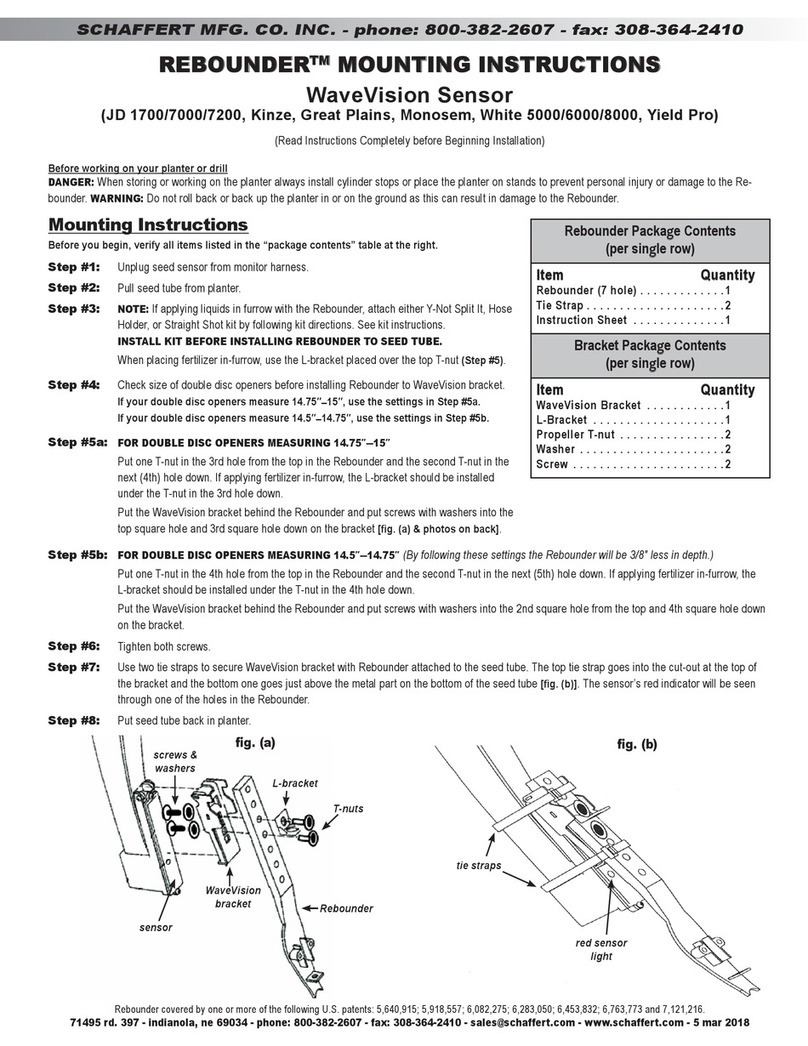
Schaffert
Schaffert Rebounder Mounting instructions

Stocks AG
Stocks AG Fan Jet Pro Plus 65 Original Operating Manual and parts list
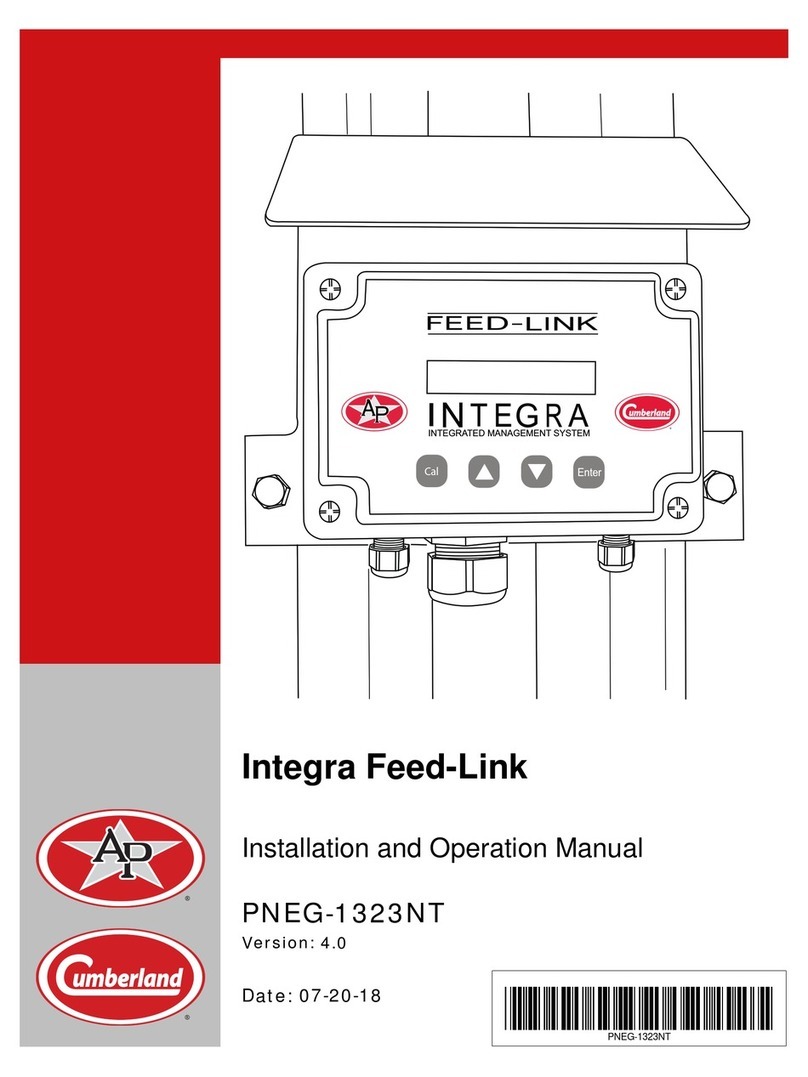
Cumberland
Cumberland Integra Feed-Link Installation and operation manual
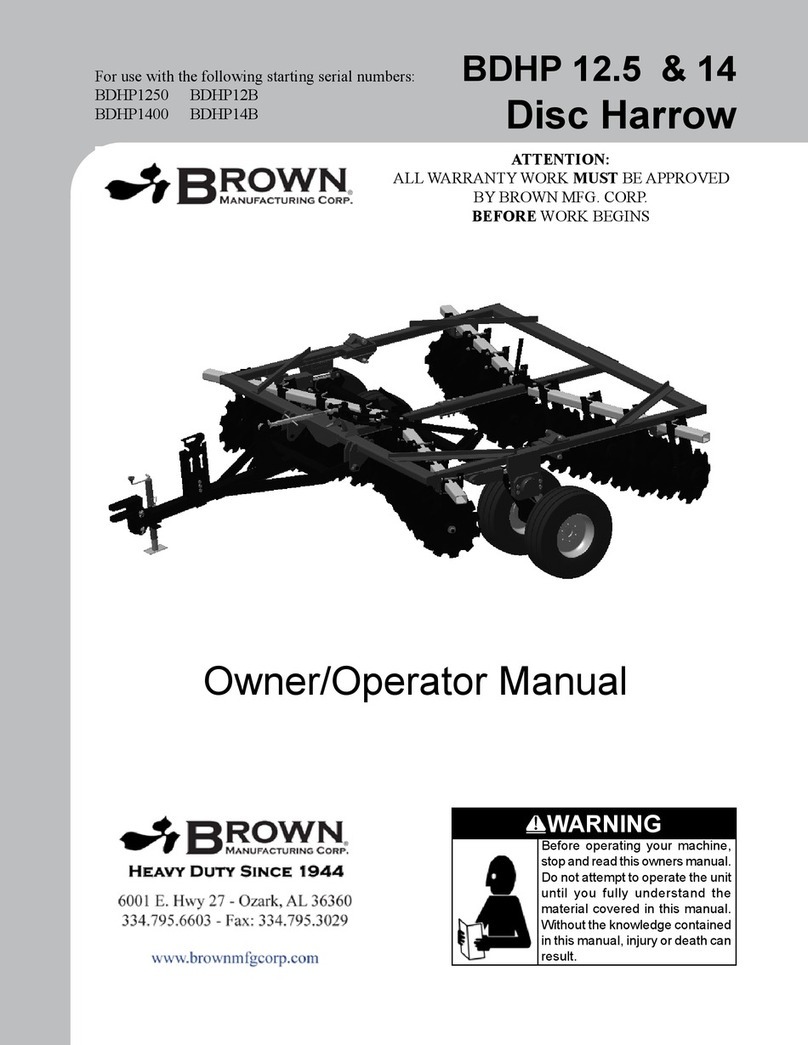
BROWN
BROWN BDHP-1250 Owner's/operator's manual
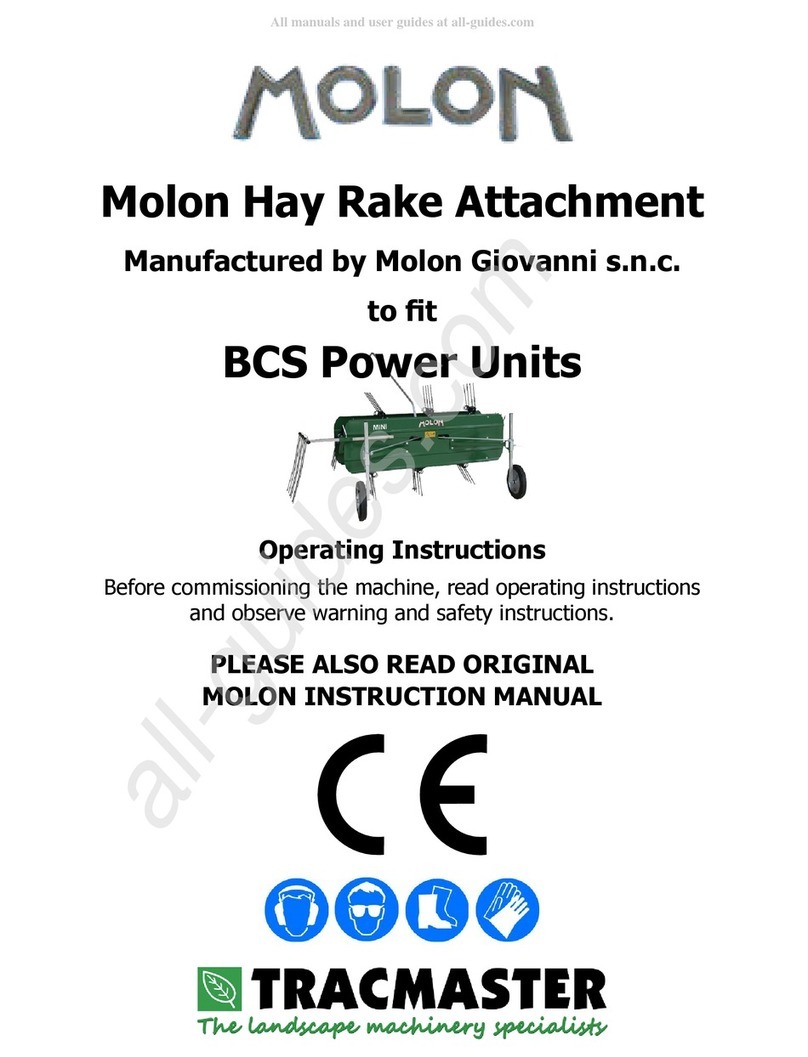
Molon
Molon BCS operating instructions
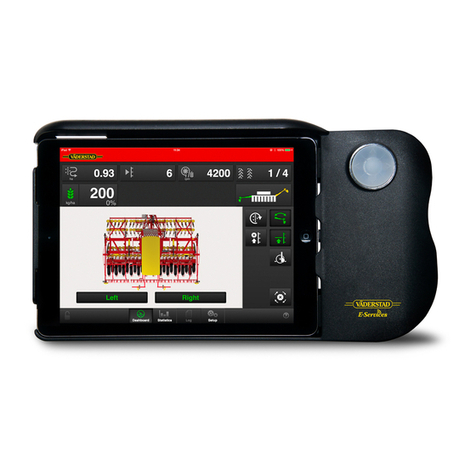
Vaderstad
Vaderstad Rapid Series instructions
